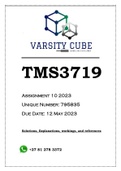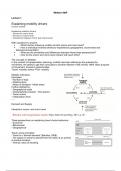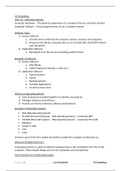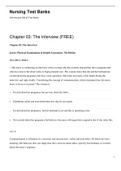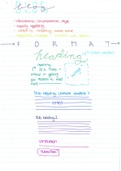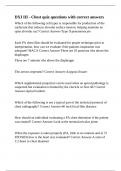Memory and Language
, Hermann Ebbinghaus (1885) = First real experimentalist (with N=1…)
• Learning: studied CVC nonsense syllables (e.g. PAB, SER, NID) to exclude prior
knowledge & understanding. 2,300 syllables, read out with metronome, in lists of
about 20 items.
• Recall. Tested himself: gave himself first item of a list, had to recall the other ones
• Insight in learning (Law of Repetition) & forgetting (Savings method – see later).
Learning curve
• Law of Repetition = More (maintenance) rehearsal ➔ better retention (but… not only
rehearsal determines learning: see later !)
• Also: law of forgetting (savings method) in E&K
Phases of memory / processes
• Acquisition/Encoding = how new information is placed in memory.
• Storage = where it is held in memory (“memory trace”).
o probably 2 steps: temporary memory trace in hippocampus, then integration in
cortical information networks.
• Retrieval =“remembering”, memory brought back into active use.
Storage: Maintaining Information in Memory
Memory can be subdivided into 3 different stores: Sensory -, Short-term -, and Long-term
memory → multi-store model
Sensory memory = Fills in the blanks when there is intermittent stimulation (e.g. sparkler,
‘What did you say?’)
Sensory store = Function: to keep sensory information in mind so we can attend to it (if we
want to)
iconic memory – for vision
echoic memory – for hearing
haptic memory – for touch
olfactory memory – for smell
gustatory memory – for taste
Evidence on capacity and duration
George Sperling (1960)
Classic experiment on visual sensory store
iconic memory capacity? = the sum of the average performance for each row, for each partial
report condition
Sperling: 2 main conclusions
Capacity = Large amount held in iconic memory (perhaps anything entering the visual
system)
Duration = After about 250-500 ms, performance approached full-report condition
information in iconic memory decays rapidly (±0.5 s) anything left was transferred to
STM before it was lost
All letters were held in sensory memory for short time but decayed rapidly. Tone acts as a
spatial attention cue. Attention -> STM
Echoic memory (Darwin et al., 1972)
• same set-up as Sperling but with headphones
, Hermann Ebbinghaus (1885) = First real experimentalist (with N=1…)
• Learning: studied CVC nonsense syllables (e.g. PAB, SER, NID) to exclude prior
knowledge & understanding. 2,300 syllables, read out with metronome, in lists of
about 20 items.
• Recall. Tested himself: gave himself first item of a list, had to recall the other ones
• Insight in learning (Law of Repetition) & forgetting (Savings method – see later).
Learning curve
• Law of Repetition = More (maintenance) rehearsal ➔ better retention (but… not only
rehearsal determines learning: see later !)
• Also: law of forgetting (savings method) in E&K
Phases of memory / processes
• Acquisition/Encoding = how new information is placed in memory.
• Storage = where it is held in memory (“memory trace”).
o probably 2 steps: temporary memory trace in hippocampus, then integration in
cortical information networks.
• Retrieval =“remembering”, memory brought back into active use.
Storage: Maintaining Information in Memory
Memory can be subdivided into 3 different stores: Sensory -, Short-term -, and Long-term
memory → multi-store model
Sensory memory = Fills in the blanks when there is intermittent stimulation (e.g. sparkler,
‘What did you say?’)
Sensory store = Function: to keep sensory information in mind so we can attend to it (if we
want to)
iconic memory – for vision
echoic memory – for hearing
haptic memory – for touch
olfactory memory – for smell
gustatory memory – for taste
Evidence on capacity and duration
George Sperling (1960)
Classic experiment on visual sensory store
iconic memory capacity? = the sum of the average performance for each row, for each partial
report condition
Sperling: 2 main conclusions
Capacity = Large amount held in iconic memory (perhaps anything entering the visual
system)
Duration = After about 250-500 ms, performance approached full-report condition
information in iconic memory decays rapidly (±0.5 s) anything left was transferred to
STM before it was lost
All letters were held in sensory memory for short time but decayed rapidly. Tone acts as a
spatial attention cue. Attention -> STM
Echoic memory (Darwin et al., 1972)
• same set-up as Sperling but with headphones


